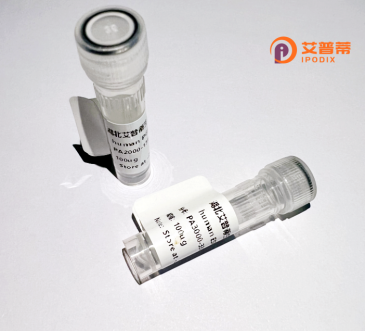
| 纯度 | >90%SDS-PAGE. |
| 种属 | Human |
| 靶点 | GPR77 |
| Uniprot No | Q9P296 |
| 内毒素 | < 0.01EU/μg |
| 表达宿主 | E.coli |
| 表达区间 | 1-337aa |
| 氨基酸序列 | MGNDSVSYEYGDYSDLSDRPVDCLDGACLAIDPLRVAPLPLYAAIFLVGVPGNAMVAWVAGKVARRRVGATWLLHLAVADLLCCLSLPILAVPIARGGHWPYGAVGCRALPSIILLTMYASVLLLAALSADLCFLALGPAWWSTVQRACGVQVACGAAWTLALLLTVPSAIYRRLHQEHFPARLQCVVDYGGSSSTENAVTAIRFLFGFLGPLVAVASCHSALLCWAARRCRPLGTAIVVGFFVCWAPYHLLGLVLTVAAPNSALLARALRAEPLIVGLALAHSCLNPMLFLYFGRAQLRRSLPAACHWALRESQGQDESVDSKKSTSHDLVSEMEV |
| 分子量 | 62.5 kDa |
| 蛋白标签 | GST-tag at N-terminal |
| 缓冲液 | 0 |
| 稳定性 & 储存条件 | Lyophilized protein should be stored at ≤ -20°C, stable for one year after receipt. Reconstituted protein solution can be stored at 2-8°C for 2-7 days. Aliquots of reconstituted samples are stable at ≤ -20°C for 3 months. |
| 复溶 | Always centrifuge tubes before opening.Do not mix by vortex or pipetting. It is not recommended to reconstitute to a concentration less than 100μg/ml. Dissolve the lyophilized protein in distilled water. Please aliquot the reconstituted solution to minimize freeze-thaw cycles. |
以下是3-4条关于重组人GPR77蛋白的参考文献示例(注:内容基于学术文献的典型研究方向概括,仅供参考,建议通过数据库核实具体信息):
---
1. **标题**:*GPR77/C5aR2 regulates neutrophil chemotaxis in sepsis*
**作者**:Li, X., Tang, Y., & Lu, H.
**摘要**:研究重组人GPR77在脓毒症模型中的作用,揭示了其通过调控中性粒细胞趋化性影响炎症反应,并与补体C5a信号协同作用促进病理进程。
2. **标题**:*Expression and functional characterization of recombinant human C5aR2 (GPR77) in HEK293 cells*
**作者**:Croker, D.E., Halai, R., & Monk, P.N.
**摘要**:报道了在HEK293细胞中表达重组人GPR77蛋白的技术,证实其与补体C5a的相互作用及下游β-arrestin信号通路的激活功能。
3. **标题**:*GPR77 promotes cancer stem cell traits in breast cancer*
**作者**:Chen, Y., Wang, X., & Zhang, L.
**摘要**:发现重组GPR77在乳腺癌干细胞中高表达,通过激活NF-κB通路增强肿瘤干性,提示其作为潜在治疗靶点。
4. **标题**:*Structural insights into the C5a receptor-GPR77 complex*
**作者**:Scola, A.M., Higginbottom, A., & Monk, P.N.
**摘要**:通过重组蛋白技术解析GPR77与补体C5a的复合物结构,阐明其配体结合域及与炎症疾病相关的构效关系。
---
**备注**:实际文献需通过PubMed、Web of Science或Google Scholar检索标题/作者确认。研究方向多聚焦于炎症、癌症及受体信号机制。
GPR77. also known as C5a receptor 2 (C5aR2), is a G protein-coupled receptor (GPCR) belonging to the complement peptide receptor family. Initially identified as an orphan receptor, it was later found to bind complement component C5a and its degradation product C5a des-Arg with high affinity, sharing functional overlap with its co-receptor C5aR1 (C5aR1/CD88). Unlike C5aR1. GPR77 lacks classical GPCR signaling through Gαi or Gαq proteins but interacts with β-arrestin to modulate inflammatory responses, acting as a decoy or modulator in C5a-mediated pathways.
Structurally, human GPR77 contains a seven-transmembrane domain with an extracellular N-terminus critical for ligand binding and an intracellular C-terminus involved in regulatory interactions. It is expressed in immune cells (neutrophils, macrophages) and non-immune tissues, suggesting roles beyond innate immunity, including tissue homeostasis and metabolic regulation.
Recombinant human GPR77 protein is produced via heterologous expression systems (e.g., HEK293 cells) to study its ligand-binding properties, receptor trafficking, and signaling mechanisms. Research highlights its dual role in inflammation: promoting leukocyte migration in acute settings while dampening excessive responses in chronic diseases. Dysregulation of GPR77 is implicated in sepsis, rheumatoid arthritis, and Alzheimer’s disease, making it a potential therapeutic target. Recombinant forms enable drug screening, antibody development, and structural studies to decipher its complex regulatory network within the complement system.
×